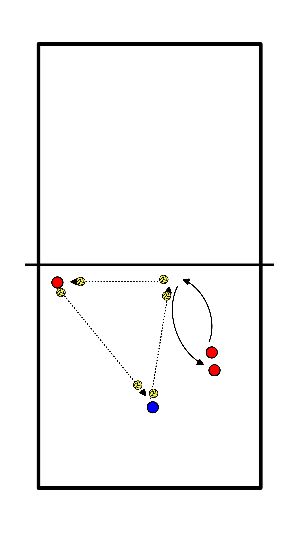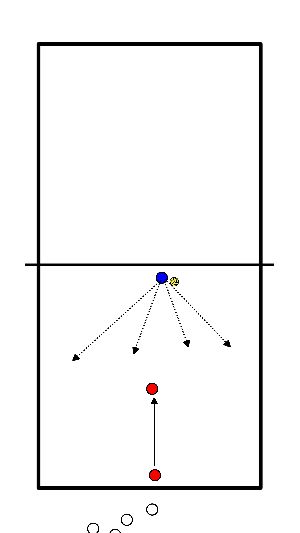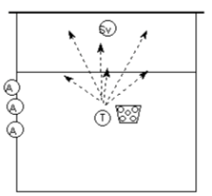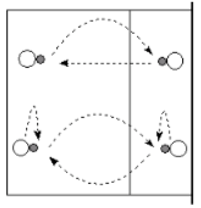Volleyball drills
- 1 player at pos 5 throws in the ball to pos 3 (SV).
- 2 players take turns to walk in from pos 1 to pos 3 (SV).
- From here they take care of the setup to pos 4.
- At pos 4, one player stands on an elevation (e.g. plinth/cabinet) to catch the ball and pass it to pos 5.
https://www.youtube.com/watch?v=_qQZSwT531Y

- 1 player at position 2.
- 1 player on position 3.
- Coach or player on position 4.
- Rest of the players in a line behind the back line at position 1.
- Player at position 2 throws a deep ball.
- Player passes back.
- Player at position 3 throws a short ball inside the three meter line.
- Player passes back ball.
- Player/coach at position 4 hits or throws a deep ball.
- Player passes it back and joins the back of the row again.
- Don't forget to pass regularly!
- Coach stands in the middle by the net.
- Line of three players stand behind the back line.
- Trainer throws balls alternately to the right and then to the left.
- Players start walking in circles because they are in threes.
- Players who are not in line are collecting balls.
- Code warm-up game.
- You make 2 or 3 groups.
- You come up with a code of about 8 numbers. {depending on the condition of the team}
- Say my code is 11325543.
- 1- 2 x run to the net and back.
- 2- 5x abs.
- 3- 5 times blocking.
- 4- 2 x dive.
- 5- 20 seconds in sitting position against the wall.
- The pair tries to decipher the code.
- They do 1 of the 5 exercises, then come to the trainer to see if the number is correct.
- If yes:
- May they try to guess the next one.
- If no:
- They have to choose another number to guess the code.
- Who deciphers the code first, wins.
- This exercise trains the split step.
- Players line up behind the back line.
- Trainer or player stands at the net.
- One by one the players walk in from the back line.
- When the trainer hits the ball, the player makes a split step.
- Then he gets the ball on a random spot next to or in front of him.
- Player passes back and retrieves ball if necessary.
- After that the player closes in at the back.

- Make 3 team, per team 1 ball and 1 bench.
- Benches at equal distance (triangle with 3 teams).
- Teams try to score by bouncing the ball on an opponent's bench each time.
- 1 point each time. Never the same person in a row.
- The teammate defends the bench.
- Which team will have 10 points first?
- Variation:
- No running with the ball (i.e. throwing).
- Each player has a sit up ball - 9 different core-stability exercises
- The Grasshopper:
- To get the most benefit from this exercise, make sure your body is in a straight line from head to toe, your hips are square (parallel to the ground) and your abs are tucked in and braced.
- Your hips should not sink at all during the movement, especially when you return to full length from the knees inwards.
- Another important point is to make sure your shoulders fall over your hands at all times, so your body doesn't rock back and forth, largely losing the benefit of this stability ball exercise.
- If you have sensitive wrists, use a pair of dumbbells as a base for your hands, this will keep your wrists in a more neutral position and reduce their strain.
- Push ups:
- Keep your hands on the side of the ball so your wrists are more neutral and very slowly lower to the ball to make this a good challenge.
- Just before your torso hits the ball, explosively (yet controlled) push back up.
- Straight Leg Deadbug:
- To get the most out of this exercise, make sure your arms and legs are always pressed into the ball.
- Even if you extend one arm and leg to just above the ground, the leg and arm still holding the ball should be pressed into the ball.
- Back leg position:
- Place your arms to the side or under the lower back if more support is needed there.
- Start with your legs perpendicular to the ground and on either side of the ball.
- Then rotate your legs so that your right leg is in front of the ball (facing you), while your left leg is on the other side (facing away from you).
- Pause at the end of each turn and then turn again so that the legs are reversed.
- Hamstring Roll-Ins:
- The key is to keep your hips high the entire time, so that your body is in a straight diagonal line from your feet to your head.
- Dig your heels into the ball as you drag it back to your buttocks.
- Squeeze your hamstrings and return SLOWLY to your legs fully extended (remember to keep your hips up).
- Ball Sensitive Twists:
- Start with your hands on the ground, shoulders above your hands, abs braced, body in a straight line and feet on either side of the ball, activating your groins to keep your legs from slipping.
- This alone is a huge benefit.
- Next, slowly rotate your hips to the right so that your foot touches the ground.
- Use your obliques to pull your hips back square and then to the other side.
- Remember to keep your hips at shoulder height the entire time.
- Ball Planks:
- Here I want you to dig your forearms and especially your wrists into the ball.
- This alone will increase your core activation 10-fold.
- Tighten and brace your abs, keep your hips up, and glutes and quads contracted.
- Next, simply move the ball around in a small circular motion, moving only your arms.
- Your whole body should stay still like cemented concrete.
- Lateral Scratch Runs:
- The ball should be under your head and shoulders and feel like a pillow, while your arms are stretched out to the side and fully locked/contracted.
- As with all of these stability ball exercises, the key with this one is to make sure your hips are up and your body is in a straight line from your knees to your shoulders.
- Push-Ups:
- This is a pretty easy move as you go down and pull your knees towards your wrists.
- This, of course, also causes the ball to roll inward.
- But the real test begins when you push yourself out of this "tucked in" position. Try it and convince yourself.
- Exercise to make several quick movements in a row and play high enough.
- Every child stands with the ball one meter from the net.
- Throw the ball over the net with a forearm movement and catch it on the other side.
- Throw the ball over the net with an overhead movement and catch it on the other side.
- Throwing the ball over the net overhead and catching it for yourself at the other side with forearms.
- If necessary, make it more difficult by varying height and distance.
- You have 2 teams one is on one side of the field and the other on the other side.
- There is a ball played in the field the ball may fall on the ground 0/1 time the ball is passed by the teams to the other side of the field.
- If the ball either bounces 1/2 time, goes out or wrong technique a team has a point.
- 4 benches, in pairs to the other side, next pair can as soon as the first bench is free.
- Each pair starts on the other side of the same bench.
- Walk across the bench, pass each other in the middle.
- Walk along the bench, jump in the middle and clap hands together, then the next bench.
- Everybody hops over the bench 4 times with hands on the bench. (move towards each other)
- Each a ball, walk over the bench, pass each other in the middle, while bouncing the ball.
- Bounce the ball, walk along the bench, jump in the middle and clap hands together.
- One ball in pairs, each on one side of the bench.
- Pass the ball while going from right to left (always closer to the middle and then further away again).
- Move sideways.
- Idem one side underarm return.
- Play one side overhead.
Trainer throws balls
- Sv plays set-up
- Attackers attack over the net. Go and get the ball. On the other side of the net
- Place ball in ballcarrier
- Also perform with set-up to position 2
- Also perform with alternating set-up to position 2 and position 4.
- Trainer throws 6 balls on different spots.
- Sv must always return to home position.

Three balls per two players.
- Throw your own ball and catch it again.
- Third ball is tested over and over again
- Same as in jump pass









